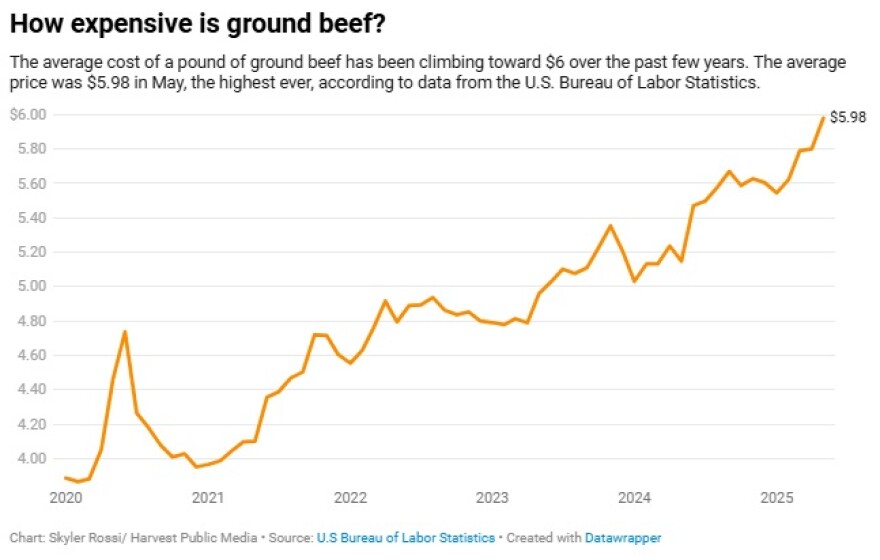In the past, ranchers used to worry whether people would eat beef.
That’s not a concern anymore, according to Mark Gardiner. Today, he said producers like himself are seeing the greatest demand in history.
“Beef has differentiated itself as the protein of choice, not only in the U.S., but worldwide,” he said.
The fourth-generation producer, who runs Gardiner Angus Ranch in southwest Kansas with his family, believes that’s largely because of the quality of beef consumers get today.
But even as beef prices hit record highs in May, demand does not appear to be slowing.
The average price of a pound of ground beef hit a record $5.98 in May, according to the most recent data from the U.S. Bureau of Labor Statistics. That’s a 16% increase from a year before, and with a short supply of cattle, experts say they don’t expect prices to fall anytime soon.

The smallest herd in decades
The cattle inventory in the U.S. is at its lowest since 1951, according to USDA data.
Ranchers have shrunk their herds for several reasons; including inflation and the rising costs of caring for cattle. Drought throughout the Great Plains, where most of the country’s cattle are raised, also means higher feed costs for ranchers.
“So we are continuing to be very small and again, smaller than we intended to be,” said Derrell Peel, a livestock marketing specialist with Oklahoma State University Extension, to KOSU last February. “And that's gonna lead to growing incentives, I think, for the industry to try to rebuild and when we can, if Mother Nature lets us.”
Because producers have been seeing strong demand at high prices, Peel said they are in the driver’s seat in this market. Although high prices likely will encourage rebuilding herd sizes, he said producers have not responded so far.
When they do, it may shrink supply even further, as ranchers hold back cows to breed more calves.
“If you're not familiar with the beef industry, you don't turn this thing around rapidly,” Peel said. “Just the nature of cattle production is a slow process.”
Cortney Cowley, a senior economist at the Federal Reserve Bank of Kansas City, said producers are looking at their input costs and looking at the prices for cattle to make decisions on whether to sell cattle or hold them back.
“And it’s really difficult to not sell right now at the historically high prices that ranchers are seeing,” Cowley said.

High prices likely to continue
Because there are fewer cattle going through the system, Cowley said meatpackers at the wholesale level are paying more for cattle resulting in lower margins. Ultimately, those high prices get passed on to the consumers, because everyone else in the supply chain has had to pay more.
At the same time, Cowley said the U.S. consumes more beef than it produces — importing meat to make up the difference — which can contribute to higher prices.
“We actually have a trade deficit for beef right now … ,” Cowley said. “and with some of the trade policies that are in effect now, whenever you have to import more beef, that can be more expensive.”
Tariffs could push prices even higher.
Peel said while the beef industry hasn’t been directly affected yet, he expects it will be down the line.
“I mean, “the export markets are all messed up” is not a very technical term, but there's a lot of disruption and more importantly, a lot of uncertainty about those markets,” Peel said. “But those effects don't show up necessarily immediately, at least not to a great extent, but they will continue to build over time.”
Peel said he’s more concerned about the broader economy. While demand for beef is solid, he said if consumers face factors like unemployment, demand could be impacted at some point.
For the moment, beef producers like Gardiner are taking the markets in stride.
A few years ago during the COVID-19 pandemic, he said producers had a difficult time because cattle could not get through the system while meat processing plants were shut down.
“So, it was frustrating to producers because the price that they were receiving was nowhere close to what they would see retail prices,” Gardiner said.
Currently, it’s a different story. He said producers are seeing record high prices as processors see the lows. Despite uncertainty over tariffs, Gardiner said producers are having a good moment.
“It's never been better in the beef industry, and I've been bullish my entire life,” he said, “But we have more opportunity today than any time in the history of American beef production.”
This story was produced in partnership with Harvest Public Media, a collaboration of public media newsrooms in the Midwest and Great Plains. It reports on food systems, agriculture and rural issues.

